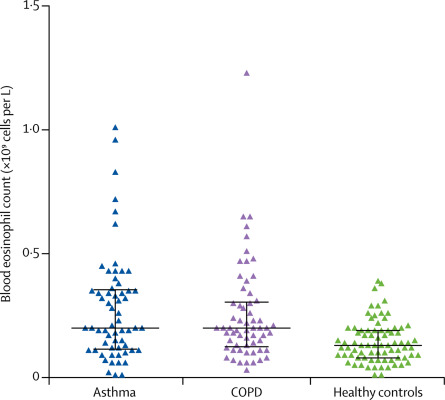Our official English website, www.x-mol.net, welcomes your
feedback! (Note: you will need to create a separate account there.)
Eosinophils in COPD: just another biomarker?
The Lancet ( IF 98.4 ) Pub Date : 2017-09-01 , DOI: 10.1016/s2213-2600(17)30217-5 Mona Bafadhel 1 , Ian D Pavord 1 , Richard E K Russell 1
The Lancet ( IF 98.4 ) Pub Date : 2017-09-01 , DOI: 10.1016/s2213-2600(17)30217-5 Mona Bafadhel 1 , Ian D Pavord 1 , Richard E K Russell 1
Affiliation

|
Eosinophils are innate immune cells that, under certain conditions, can be recruited to the lungs, where they have an incompletely understood role in health and disease. Eosinophils have been found in the airways, tissues, and circulation of patients with COPD, during both stable disease and exacerbations. Epidemiological studies and post-hoc analyses of clinical trials of corticosteroid treatment for COPD have shown that the blood eosinophil count is associated with the risk of COPD exacerbations, mortality, decline in FEV1, and response to both inhaled and systemic corticosteroids. Further studies are urgently needed to explore the contribution of eosinophils to the mechanism of disease in COPD and to identify their association with levels of clinical risk. In this review, we explore the role of the eosinophil as a biomarker and mediator of disease in COPD.
中文翻译:

COPD中的嗜酸性粒细胞:只是另一种生物标志物?
嗜酸性粒细胞是先天免疫细胞,在某些条件下,它们可以被募集到肺部,在那里它们在健康和疾病中的作用尚不完全清楚。在慢性阻塞性肺病患者的气道、组织和循环中发现了嗜酸性粒细胞,无论是在疾病稳定期还是病情恶化期间。对 COPD 皮质类固醇治疗临床试验的流行病学研究和事后分析表明,血嗜酸性粒细胞计数与 COPD 恶化、死亡率、FEV 1下降的风险相关,以及对吸入和全身皮质类固醇的反应。迫切需要进一步的研究来探索嗜酸性粒细胞对 COPD 疾病机制的贡献,并确定它们与临床风险水平的关系。在这篇综述中,我们探讨了嗜酸性粒细胞作为 COPD 疾病的生物标志物和介质的作用。
更新日期:2017-08-10
中文翻译:

COPD中的嗜酸性粒细胞:只是另一种生物标志物?
嗜酸性粒细胞是先天免疫细胞,在某些条件下,它们可以被募集到肺部,在那里它们在健康和疾病中的作用尚不完全清楚。在慢性阻塞性肺病患者的气道、组织和循环中发现了嗜酸性粒细胞,无论是在疾病稳定期还是病情恶化期间。对 COPD 皮质类固醇治疗临床试验的流行病学研究和事后分析表明,血嗜酸性粒细胞计数与 COPD 恶化、死亡率、FEV 1下降的风险相关,以及对吸入和全身皮质类固醇的反应。迫切需要进一步的研究来探索嗜酸性粒细胞对 COPD 疾病机制的贡献,并确定它们与临床风险水平的关系。在这篇综述中,我们探讨了嗜酸性粒细胞作为 COPD 疾病的生物标志物和介质的作用。










































 京公网安备 11010802027423号
京公网安备 11010802027423号